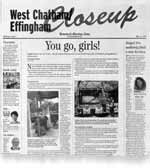Fall 2000
Neighborhood Newsroom’s First Grads
By Pat Ford
Pew Center
 “You go, girls!” read the headline on the feature story that dominated the front page of a recent edition of Closeup, the weekly community news insert in the Savannah Morning News. The story profiled four women in non-traditional jobs: a pipefitter, a sanitation worker, a truck driver and a flight instructor.
“You go, girls!” read the headline on the feature story that dominated the front page of a recent edition of Closeup, the weekly community news insert in the Savannah Morning News. The story profiled four women in non-traditional jobs: a pipefitter, a sanitation worker, a truck driver and a flight instructor.
The writer knew her subject. She knew it a whole lot better than you’d expect of a newspaper reporter. That’s because she spent most of her career in one of those non-traditional jobs and only recently made the transition to journalism with the help of an innovative new program that is helping both to diversify the Morning News‘ staff and create closer ties to the community.
Former pipefitter Margaret Bailey is one of the first graduates of the Savannah Morning News Neighborhood Newsroom. After studying journalism at the paper for two hours on weeknights through the month of June, in classes led by Morning News editors, Bailey and several of her fellow students began writing stories for Closeup.
“I feel I bring something new and different to the paper,” said Bailey, who’s already had half a dozen stories since graduating from the program. “When I first went to the paper, [editor Steve Corrigan] said, ‘See all the faces here. There’s no black faces and I need to change that; to get another perspective on the community, to get how other people think.’ So I think with more minority writers, it gives a different perspective about what’s important.”
Morning News managing editor Dan Suwyn came up with the program, looking not just for ethnic diversity but also for a way to penetrate communities of people who are often overlooked by newspapers.
“Back in the old days,” said Suwyn, “you had a lot more working people in the newsroom. Different kinds of people became journalists. I like the idea of reaching into communities you want to get into and getting people into the paper, rather than us trying to get into their neighborhoods.”
So the paper went to local colleges and community centers with writing programs and asked them to nominate students for the program. Closeup editor Corrigan agreed to run it. He put together a strenuous application, asking for a 350-word essay and two shorter essays. From about two dozen applicants, he chose a class of 10.
“I wanted to see that they could at least form sentences, if they had any kind of an eye for detail or turn of phrase,” said Corrigan. “More than anything, you couldn’t fill out this application in five minutes. It took some commitment.”
Nine of the 10 applicants Corrigan selected took the course. All were women; they ranged in age from their 20’s to their 50’s. Six were African-American, one was Latino and two were white. They were paid $400 to attend 32 hours of classes.
Classes were held from 7-9 p.m., Monday through Thursday, on topics such as interviewing sources, taking notes, writing leads, revising stories and taking pictures. Top editors from the paper taught the course.
Corrigan gave writing assignments each week and edited the stories mercilessly. “I was tough,” he admitted. But Bailey, for one, didn’t mind. “I needed that,” she said.”I don’t need anyone to baby me. My goal is to get on page 1-A so I needed someone to point out my errors.”
Suwyn and Corrigan said they would have been happy if even half the students stayed with the program.
But all nine students did, indeed, graduate. Six have had stories published. Corrigan says it is still a lot of work to edit the writing into shape for publication but he believes his former students are absorbing the most important aspects of the profession. For instance, he sent Bailey to do a feature on a woman about to turn 110 but, in interviewing her relatives, Bailey found some discrepancy about her actual age and put off the story until she could confirm the woman’s birth date. Her wariness and her concern for accuracy pleased Corrigan.
Bailey, in turn, seems thrilled with her new career. She recently got her first written feedback, a letter from the Rotary Club president praising her coverage of a meeting with the lieutenant governor. “‘We will vote for your Pulitzer’,” she quotes from the letter. “I was just so proud of that.
“My sister says, ‘I just can’t believe they print what you write.’ And I’m still very nervous. I’m still in awe that I’m going to the paper and they’re going to look at something I’ve written. But I tell Steve, I want page 1-A.”
Corrigan thinks she has a good chance of getting there. Three of his former Closeup correspondents are now on the Morning News staff. One is a bureau chief.
And Suwyn makes it clear he wants the Neighborhood Newsroom graduates to succeed. He believes the program is a good way for a small paper like the Morning News to recruit a diverse staff, given the competition from big papers for talented minority journalists.
“We need to keep reaching out,” said Suwyn. “We’ll do it again next year. And if some of them get so good they go to The New York Times or The Washington Post, that’s even better.”
